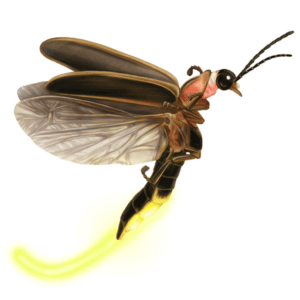Observation: Photinus pyralis
Primary Observer:
Debi Domby
Event Date:
2024-08-16
Status:
Verified

Survey
Site Name:
Home Backyard
Province/State:
Michigan
Event Date:
2024-08-16
Time of Day:
Night-Time
Start Time:
20:45
End Time:
21:15
Number of Observers:
1
Primary Observer:
Debi Domby
Additional Observers:
n/a
Target Species Genus:
Photinus
Target Species Species:
pyralis
Location and Habitat
Location Accuracy (meters):
0-25
Habitat Type:
Developed - Sub/urban areas; parks/gardens
Habitat Type Notes:
Mowed backyard with few trees/bushes... some low plants
Elevation (meters):
182.88
Area Searched (hectares):
0.01114836
Artificial Light Sources
Vehicles: No
Street Lights: Yes
Buildings: No
Street Lights: Yes
Buildings: No
Artificial Light Types
Sky Glow (diffuse illumination in the sky): No
Light Trespass (light cast on surfaces beyond its intended target): No
Glare (bright light causing visual discomfort): No
Light Trespass (light cast on surfaces beyond its intended target): No
Glare (bright light causing visual discomfort): No
Artificial Light Notes:
Observation
Observation Type:
Flashing
Number Observed:
11-50
Genus:
Photinus
Species:
pyralis
Observation Notes:
8/16 20:53
Wind SE 5
Partly Cloudy
Temp 75.9
Dewpoint 69.1
Humidity 79%
Humidex 77
Pressure 29.81
In 15 minutes got total of 35 FF. Colors mostly Green, Orange and White.
Interval (10-12 sec), largest counts were 7,8,6 (the other 14 were other counts)
Interval between flashes about 4.75-5. Length of flash, about .5-.75 (don't time, but it's what I use)
Every year when the cicadas begin singing, the firefly population will fall and usually fall fast. When we had a hot streak late July, early August... got about 15 FF per 10 sec count. In June, early July, that amount is over 80 per 10 second count. (they flash so fast, the best you can do is count by batch, I use 5, although it's probably higher... about the fastest I can count is to 80, I suspect it's probably higher)
After all these years, it's like clockwork singing cicadas = less FF.
Also at this time of year, like spring when the FF first appear, they don't stay in the same area for long. Sometimes when they flash at the right time, you'll see a light trail following them. I'm lucky to get 3-4 intervals timed out.
Another thing, at this time of year, the FF flashes are dimmer. All I can figure it's the cool temps. I saw brighter ones a couple weeks ago when the humidity/dewpoint were high and very muggy out. As I said, earlier in the season, I would've had 4x as many, so many that you can't count them you just estimate your eyes can take in 5-7 of them flashing simultaneously, but this late in the season, the amount is drastically reduced. They don't even get to my front yard where I do my timings.
Please in 2025 think about allowing us volunteers to send in Excel/CSV files for the week or month. In lieu of that, allow us to choose what is saved so you're not putting the same thing in daily. This is why I skipped probably 3 weeks. Just didn't have the time to fill everything in (I do incidental sighting and it's the same spot every day. You'd probably get more data in for your study if you didn't have to remember where your location is above sea level and the hec amount. Thank you for letting me send you my feedback
Specimen Voucher Number:
Flash Behavior
First Flash Time:
20:50
Last Flash Time:
21:10
First Flash Temp (F):
75.9
Last Flash Temp (F):
79.5
Flashes in Pattern:
1
Flash Color:
Green
Flash Pattern Period:
4.75
Flash Duration:
.5
Flash Interval:
5.25
Male Height Zone:
Moderate (3-8 ft)
Flash Location:
mowed grass, suburban, light vegetation along one fence line



